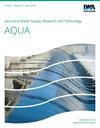巴西富营养化城市河流中蓝藻的季节性动态和多样性
IF 4.3
Q2 Environmental Science
引用次数: 0
摘要
地表水体容易受到蓝藻过度生长的影响,这主要是由于营养物的富集、气温的升高和经常性的干旱。定期监测水系统中的蓝藻对预防和管理与毒素接触有关的健康风险至关重要。2018-2022年,在巴西圣保罗州Jundiai河采集地表水样本,研究蓝藻的季节变化和物种多样性。该研究还旨在了解蓝藻丰度、气候、水质和水文参数之间的关系。数据分析显示,在干旱季节(DS)蓝藻细胞计数显著升高的模式,伴随着蓝藻物种的增加。已确定的物种由于可能产生毒素以及造成令人不快的味道和气味而对水安全构成威胁。DS的特点是营养物质浓度高,水流小。磷含量仍然很高,使得蓝藻可以在不受营养物质限制的情况下生长。在未来的情况下,君迪亚河的主要问题不是温度上升,而是干旱,为蓝藻的繁殖创造了一个稳定的环境。该研究为河流用水用户提供了有价值的数据,并有助于更广泛地了解全球蓝藻分散。本文章由计算机程序翻译,如有差异,请以英文原文为准。
Seasonal dynamics and diversity of cyanobacteria in a eutrophied Urban River in Brazil
Surface water bodies are vulnerable to cyanobacteria overgrowth, primarily owing to nutrient enrichment, rising temperatures, and recurrent droughts. Regular cyanobacteria monitoring in water systems is crucial to prevent and manage health risks associated with toxin exposure. Surface water samples were collected from the Jundiai River in Sao Paulo State, Brazil for 3 years (2018–2022) to study the seasonal changes and species diversity of cyanobacteria. The study also aimed to understand the relationship between cyanobacteria abundance, climate, water quality, and hydrological parameters. Data analyses revealed a pattern of significantly elevated cyanobacterial cell counts during the dry season (DS), accompanied by an increase in the cyanobacterial species. The identified species poses a threat to water safety owing to the potential production of toxins, as well as causing unpleasant taste and odor. The DS is marked by higher nutrient concentrations and lower water flow. Phosphorus levels remain high, allowing cyanobacteria to grow without being limited by nutrients. In future scenarios, the primary concern for the Jundiai River is not temperature rise but droughts that create a stable environment for cyanobacteria proliferation. This research provides valuable data for river water users and contributes to a broader understanding of the global cyanobacterial dispersion.
求助全文
通过发布文献求助,成功后即可免费获取论文全文。
去求助
来源期刊
CiteScore
4.70
自引率
0.00%
发文量
74
审稿时长
4.5 months
期刊介绍:
Journal of Water Supply: Research and Technology - Aqua publishes peer-reviewed scientific & technical, review, and practical/ operational papers dealing with research and development in water supply technology and management, including economics, training and public relations on a national and international level.

 求助内容:
求助内容: 应助结果提醒方式:
应助结果提醒方式:


